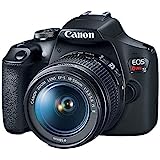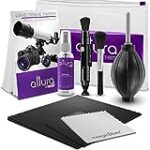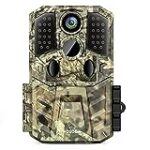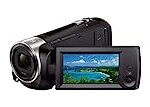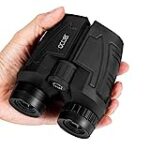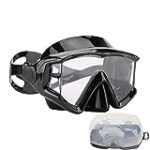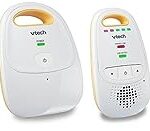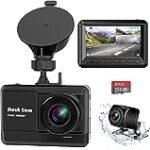🌅 Introduction
Welcome to our comprehensive DSLR cameras buying guide! If you’re an aspiring photographer or a seasoned pro looking to upgrade your gear, you’ve come to the right place. With the ever-evolving technology and a myriad of options available, finding the perfect DSLR camera can be overwhelming. But fear not, as we’re here to simplify the process for you. In this guide, we’ll explore the key factors to consider when purchasing a DSLR camera, including image quality, versatility, autofocus capabilities, and price range. So, let’s dive in and find the ideal DSLR camera that will unleash your creativity and capture those breathtaking moments!
🏆 Our Top 5
- 24.1 Megapixel CMOS (APS-C) sensor with is 100–6400 (H: 12800)
- Built-in Wi-Fi and NFC technology
- 9-Point AF system and AI Servo AF
- Optical Viewfinder with approx 95% viewing coverage
- Use the EOS Utility Webcam Beta Software (Mac and Windows) to turn your compatible Canon camera into a high-quality webcam. Compatible Lenses- Canon EF Lenses (including EF-S lenses, excluding EF-M lenses)
- This Camera Bundle Kit comes complete with all manufacturer supplied accessories and includes:
- The EOS Rebel T7 DSLR Camera from Canon has a 24.1MP APS-C CMOS Sensor and DIGIC 4+ Image Processor. It has a 3.0" 920k-Dot LCD Monitor with Full HD 1080/30p Video Recording capabilities. It offers sharp details, accurate colors and low-noise imaging in both bright and low-light shooting situations. The Rebel T& can continuously shoot up to 3 fps.
- Canon 18-55mm II Lens - a standard zoom compatible with Canon APS-C format cameras. It features a focal length range of 18-55mm which is equivalent to 29-88mm in the 35mm format
- 2 x SanDisk 64GB SDHC Memory Cards + Deluxe Padded Camera Case + Flash w/ bracket + 3pc Filter Kit + Extra Battery Pack + High Speed USB Card Reader + 50" Camera Tripod
- 0.43x Auxiliary Wideangle Lens - it conveniently mounts to the front of your fixed or zoom lens, and allows you to capture a wider field of view, 2.2x Auxiliary Telephoto Lens - brings you twice as close to the action. Perfect for long-distance photo situations such as sporting events
- DSLR quality photos & full HD movies
- Powerful 18 Megapixel sensor & precise auto focus
- 3.0 frames per second
- Canon Camera Connect App: share instantly & shoot remotely via compatible smartphone
- Easily frame your shots with the optical viewfinder
- This Al’s Variety Camera Bundle Includes Transcend 64GB Class 10 SD Memory Card,58mm Filter KIt, 58mm Tulip Hood, Tripod, Camera Gadget Bag Case, Tripod, Gripster tripod, Wrist Grip, Video/Photo Editing Software Pack, Battery Charger , Slave Flash, Lens Cap , Body Cap ,Neck Strap , AL’s Variety Lens Cleaning Cloth + 1 Year Seller Supplied Warranty , And Includes :
- Canon EOS 4000D Camera Body (International Version )- 18.0MP APS-C CMOS Sensor,DIGIC 4+ Image Processor, 6.8 cm (2.7") TFT LCD, approx. 230 K dots,,Full HD 1080p Video Recording at 29.97 fps ,9 Point Auto Focus,Dual,Up to 3 fps Shooting and ISO 12800, Scene Intelligent Auto, Instantly transfer photos and movies to your smart device, for easy sharing on social media or cloud backup, and shoot remotely with Wi-Fi and the Canon Connect app,
- Canon EF-S 18-55mm F/3.5-5.6 DC III Zoom Lens - EF-S-Mount Lens/APS-C Format, 28.8-88mm (35mm Equivalent) ,Aperture Range: f/3.5 to f/38 ,One Aspherical Element ,Super Spectra Coating ,Micro Motor AF System , Rounded 6-Blade Diaphragm
- Get easy guidance on DSLR photography with Canon’s Photo Companion app (downloadable for Android and iOS). Add lenses and accessories or take manual control when you’re ready, Capture the moment just as you remember it with precise auto focus, 3.0 fps and DIGIC 4+. Easily frame your shots with the optical viewfinder and see results on a 6.8 cm LCD screen,
- Just frame and shoot for great results with Scene Intelligent Auto. Enjoy guided Live View shooting with Creative Auto mode and add unique finishes with Creative Filters.Shoot with confidence ,Capture the moment just as you remember it with precise auto focus, 3.0 fps and DIGIC 4+. Easily frame your shots with the optical viewfinder and see results on a 2.7 Inch (6.8 cm) LCD
- This Al’s Variety Camera Bundle Includes Transcend 64GB Class 10 SD Memory Card,58mm UV Filter , 58mm Tulip Hood, Gripster tripod, Battery Charger , Lens Cap , Body Cap ,Neck Strap , AL’s Variety Lens Cleaning Cloth + 1 Year Seller Supplied Warranty , And Includes :
- Canon EOS Rebel T100 DSLR Camera Body (International Version )- 18.0MP APS-C CMOS Sensor,DIGIC 4+ Image Processor, 6.8 cm (2.7") TFT LCD, approx. 230 K dots,,Full HD 1080p Video Recording at 29.97 fps ,9 Point Auto Focus,Dual,Up to 3 fps Shooting and ISO 12800, Scene Intelligent Auto, Instantly transfer photos and movies to your smart device, for easy sharing on social media or cloud backup, and shoot remotely with Wi-Fi and the Canon Connect app,
- Canon EF-S 18-55mm F/3.5-5.6 DC III Zoom Lens - EF-S-Mount Lens/APS-C Format, 28.8-88mm (35mm Equivalent) ,Aperture Range: f/3.5 to f/38 ,One Aspherical Element ,Super Spectra Coating ,Micro Motor AF System , Rounded 6-Blade Diaphragm
- Get easy guidance on DSLR photography with Canon’s Photo Companion app (downloadable for Android and iOS). Add lenses and accessories or take manual control when you’re ready, Capture the moment just as you remember it with precise auto focus, 3.0 fps and DIGIC 4+. Easily frame your shots with the optical viewfinder and see results on a 6.8 cm LCD screen,
- Just frame and shoot for great results with Scene Intelligent Auto. Enjoy guided Live View shooting with Creative Auto mode and add unique finishes with Creative Filters.Shoot with confidence ,Capture the moment just as you remember it with precise auto focus, 3.0 fps and DIGIC 4+. Easily frame your shots with the optical viewfinder and see results on a 2.7 Inch (6.8 cm) LCD
🤔 How to choose?
1. Budget considerations
When choosing a DSLR camera, it’s important to consider your budget. DSLR cameras come in a wide range of prices, from entry-level models to professional-grade options. **Determining your budget** will help narrow down your options and ensure you find a camera that meets your needs without breaking the bank.
2. Camera type and features
There are different types of DSLR cameras available, including full-frame and crop sensor models. **Full-frame cameras** offer superior image quality and low-light performance, but they tend to be more expensive. On the other hand, **crop sensor cameras** are more affordable and suitable for beginners or hobbyists. Consider the features you need, such as **megapixel count, ISO range, autofocus system, and video capabilities**.
3. Lens compatibility
One of the advantages of DSLR cameras is the ability to interchange lenses. When choosing a DSLR camera, it’s important to consider the **availability and compatibility of lenses**. Canon and Nikon, for example, have a wide range of lenses to choose from, making them popular choices among photographers. **Research the lens options** available for the camera you are considering to ensure you can expand your photography skills in the future.
4. Ergonomics and handling
A DSLR camera is an investment, and you want to make sure it feels comfortable in your hands. **Consider the ergonomics and handling** of the camera before making a purchase. Look for a camera with a **sturdy build, well-placed buttons, and a comfortable grip**. It’s also important to consider the weight of the camera, especially if you plan on carrying it for extended periods.
5. User reviews and recommendations
Before making a final decision, it’s always a good idea to **read user reviews and seek recommendations** from photographers who have experience with the camera you are interested in. They can provide valuable insights into the camera’s performance, image quality, and overall user experience. **Look for reviews from reputable sources** and consider the feedback from photographers who have similar needs and preferences as you.
By considering your budget, camera type and features, lens compatibility, ergonomics and handling, and user reviews and recommendations, you can make an informed decision when choosing a DSLR camera. Remember, the best camera for you is the one that suits your needs and helps you capture the moments that matter most. Happy shooting!
💡 What to Look for in a dslr cameras?
1. Image Quality
When looking for a DSLR camera, one of the most important factors to consider is the image quality it produces. The image quality of a DSLR camera is determined by several factors, including the sensor size, resolution, and ISO range. A larger sensor size generally results in better image quality, as it allows for more light to be captured. Additionally, a higher resolution camera will produce sharper and more detailed images. Lastly, a wider ISO range allows for better low-light performance, which is crucial for capturing clear and noise-free images in challenging lighting conditions.
For example, the Canon EOS 5D Mark IV is known for its exceptional image quality, thanks to its full-frame sensor and 30.4-megapixel resolution. It also has an impressive ISO range of 100-32000, expandable up to 50-102400, allowing for excellent low-light performance.
2. Autofocus System
Another important aspect to consider when choosing a DSLR camera is its autofocus system. The autofocus system determines how quickly and accurately the camera can focus on a subject. A good autofocus system is essential for capturing fast-moving subjects or shooting in challenging conditions. Look for a camera with a high number of autofocus points, as this will provide more flexibility in composing your shots and ensure that your subject is in sharp focus.
For instance, the Nikon D850 boasts an advanced autofocus system with 153 focus points, including 99 cross-type sensors. This allows for precise and fast focusing, making it an excellent choice for sports and wildlife photography.
3. Ergonomics and Handling
The ergonomics and handling of a DSLR camera are often overlooked but are crucial for a comfortable shooting experience. Consider the size, weight, and layout of the camera’s buttons and controls. A camera that feels comfortable in your hands and has intuitive controls will make it easier to navigate through settings and capture your desired shots. Additionally, look for a camera with a durable build quality, as it will withstand the rigors of regular use.
For example, the Sony Alpha a7 III is praised for its ergonomic design, with a comfortable grip and well-placed buttons that are easy to reach. Its weather-sealed body also ensures durability, making it suitable for outdoor photography in various conditions.
In conclusion, when looking for a DSLR camera, prioritize image quality, autofocus system, and ergonomics and handling. These factors will greatly impact your overall shooting experience and the quality of your photographs. Remember to consider your specific needs and preferences to find the perfect DSLR camera that suits your style of photography.
🔍 How we picked?
1. Researching the Market
When it comes to buying a DSLR camera, it’s important to do your research and understand the market. With so many options available, it can be overwhelming to choose the right one. That’s why we’ve done the hard work for you, scouring the market to find the best DSLR cameras out there.
We’ve taken into consideration factors such as image quality, ease of use, features, and value for money. Our team of experts has spent countless hours testing and comparing different models to ensure that we provide you with the most accurate and up-to-date information.
2. Evaluating Image Quality
One of the most important factors to consider when buying a DSLR camera is the image quality it produces. After all, you want your photos to be sharp, vibrant, and full of detail.
We’ve carefully evaluated the image quality of each camera we reviewed, taking into account factors such as resolution, sensor size, and ISO performance. We’ve tested the cameras in various lighting conditions to see how well they perform in low light situations.
For example, one of the cameras we reviewed, the Nikon D850, received high praise for its exceptional image quality. With its 45.7-megapixel sensor and excellent dynamic range, it produces stunningly detailed images that are sure to impress even the most discerning photographers.
3. Considering Features and Ease of Use
Another important aspect to consider when buying a DSLR camera is the features it offers and how easy it is to use.
We’ve looked at a range of features, including autofocus capabilities, burst shooting speed, video recording capabilities, and connectivity options. We’ve also considered the overall ergonomics of each camera, taking into account factors such as button layout and menu navigation.
For example, the Canon EOS 5D Mark IV stood out for its advanced autofocus system, which makes it a great choice for capturing fast-moving subjects. Its intuitive menu system and touchscreen interface also make it a breeze to use, even for beginners.
In conclusion, our team has carefully researched and evaluated the DSLR camera market to provide you with the most comprehensive and reliable buying guide. We’ve considered factors such as image quality, features, and ease of use to ensure that you find the perfect camera for your needs. So whether you’re a professional photographer or a hobbyist, we’ve got you covered. Happy shooting!
💬 Frequently asked questions about dslr cameras
1. What is a DSLR camera and why should I consider buying one?
A DSLR (Digital Single-Lens Reflex) camera is a popular choice for both amateur and professional photographers due to its versatility and image quality. Unlike point-and-shoot cameras, DSLRs allow you to change lenses, giving you more control over your photography. The larger image sensor in DSLRs captures more light, resulting in sharper and more detailed images. Whether you’re a photography enthusiast or a professional looking to take your skills to the next level, investing in a DSLR camera can greatly enhance your photography experience.
2. What factors should I consider when buying a DSLR camera?
When purchasing a DSLR camera, there are several important factors to consider. Firstly, think about your budget and what you’re willing to spend. Consider the camera’s sensor size, as larger sensors generally produce better image quality. Look for a camera with a high resolution if you plan on printing your photos in large formats. Additionally, pay attention to the camera’s autofocus system, ISO range, and burst shooting speed if you’re interested in capturing fast-moving subjects. Lastly, consider the availability and cost of lenses and accessories for the camera brand you choose.
3. Can I use my existing lenses with a DSLR camera?
If you already own lenses from a previous camera, you may be wondering if they are compatible with a DSLR camera. The answer depends on the lens mount of your current lenses and the camera brand you choose. Most camera manufacturers offer adapters that allow you to use lenses from other brands, but it’s important to do your research to ensure compatibility. For example, Canon DSLR cameras use the EF lens mount, while Nikon uses the F-mount. However, keep in mind that using an adapter may affect autofocus performance and other features.
4. Are DSLR cameras difficult to use for beginners?
While DSLR cameras offer a wide range of features and settings, they can still be used by beginners. Many DSLR cameras have automatic shooting modes that make it easy to get started. As you gain confidence and experience, you can gradually explore the manual settings and unleash the full potential of your camera. Additionally, there are numerous online tutorials and resources available to help beginners learn the basics of DSLR photography. With practice and patience, anyone can become proficient in using a DSLR camera.
5. Are DSLR cameras still relevant in the age of smartphones?
With the rise of smartphones equipped with high-quality cameras, some may question the relevance of DSLR cameras. However, DSLRs still offer advantages that smartphones cannot match. The larger image sensor and interchangeable lenses of DSLRs allow for greater creative control and superior image quality. DSLRs also excel in low-light situations, thanks to their larger sensors and better noise reduction capabilities. While smartphones are convenient for everyday snapshots, DSLR cameras are essential for those who want to take their photography to the next level.
Last update on 2024-05-05 / Affiliate links / Images from Amazon Product Advertising API
